Supplying reliable seed for Maine’s developing sea vegetable aquaculture industry
PI Susan Brawley, University of Maine
Funded amount: $16,053 Matching funds: $17,815
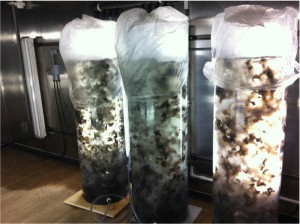 Sea vegetable aquaculture is developing rapidly in Maine, but a major limitation remains clean seed-stock and seeded lines for grow-out at scales adequate to demonstrate commercial potential throughout the State. This project will improve conditions for culture maintenance at the Center for Cooperative Aquaculture Research in Franklin and acquire kuralon line for seeding at the needed capacity. This project will result in a clean culture room that is isolated from other aquaculture activities, including early isolation chambers at CCAR and which is important to prevent contamination of cultures by ciliates and green algae. Bulk purchase of Kuralon twine will enable lines seeded with sea vegetable spores to be provided at the required scale at monthly intervals for pre-commercial tests of the best seasons and depths for grow-out of dulse and alaria. This project will support continued, reliable development of the sea vegetable industry in Maine.
Sea vegetable aquaculture is developing rapidly in Maine, but a major limitation remains clean seed-stock and seeded lines for grow-out at scales adequate to demonstrate commercial potential throughout the State. This project will improve conditions for culture maintenance at the Center for Cooperative Aquaculture Research in Franklin and acquire kuralon line for seeding at the needed capacity. This project will result in a clean culture room that is isolated from other aquaculture activities, including early isolation chambers at CCAR and which is important to prevent contamination of cultures by ciliates and green algae. Bulk purchase of Kuralon twine will enable lines seeded with sea vegetable spores to be provided at the required scale at monthly intervals for pre-commercial tests of the best seasons and depths for grow-out of dulse and alaria. This project will support continued, reliable development of the sea vegetable industry in Maine.
Determination of Vibrio parahaemolyticus status in oyster populations in Maine
PI Cem Giray, Kennebec River Biosciences
Funded amount: $7,861 Matching funds: $9,209
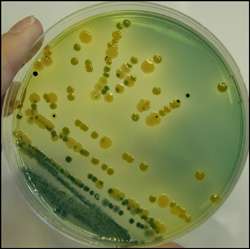 Vibrio parahaemolyticus, an organism which can cause health issues in connection with shellfish consumption, has in recent years become a major concern in southern New England states. To date, this organism has shown rare occurrence in Maine and the majority of isolates have been composed of non-pathogenic strains. Preliminary work performed by Kennebec River Biosciences, Inc. with partial funding by several Maine bivalve shellfish aquaculture companies has shown presence of this organism in some grow-out oysters. Several Maine bivalve shellfish aquaculture companies have voluntarily established harvest, handling and monitoring practices to minimize any potential effect of this pathogen on their market product. The objectives of this project are:
Vibrio parahaemolyticus, an organism which can cause health issues in connection with shellfish consumption, has in recent years become a major concern in southern New England states. To date, this organism has shown rare occurrence in Maine and the majority of isolates have been composed of non-pathogenic strains. Preliminary work performed by Kennebec River Biosciences, Inc. with partial funding by several Maine bivalve shellfish aquaculture companies has shown presence of this organism in some grow-out oysters. Several Maine bivalve shellfish aquaculture companies have voluntarily established harvest, handling and monitoring practices to minimize any potential effect of this pathogen on their market product. The objectives of this project are:
1) to screen oysters from several Maine river systems to gain a better understanding of V. parahaemolyticus presence,
2) to determine the pathogenicity of detected strains,
3) to provide growers data on the efficacy of their harvest biosecurity protocols.
Overripening as a principal cause of embryo mortality in the commercial culture of Atlantic salmon in Maine
PI Heather Hamlin, University of Maine
Funded amount: $13,387 Matching funds: $16,654
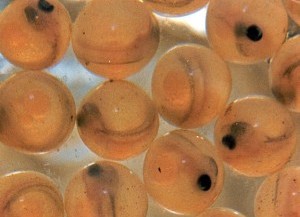 Atlantic salmon imports were valued at more than $1 billion dollars in 2013, highlighting a tremendous opportunity for increase in domestic production. Despite considerable efforts made toward understanding factors involved in the control of embryo quality in salmonids, there is still a great deal of information that is incomplete or lacking, and gamete quality remains a serious production issue in the aquaculture industry. For more than 10 years, embryo survival in Atlantic salmon has been steadily declining in Maine hatcheries. Broodstock maintenance, egg fertilization and egg incubation are costly and labor intensive, and its reduced success is becoming a serious threat to the economic viability of an important Maine industry. Previous research in our lab indicates egg overripening could be a principal cause of increasing embryo mortality, and this project seeks to understand if this is the most likely cause.
Atlantic salmon imports were valued at more than $1 billion dollars in 2013, highlighting a tremendous opportunity for increase in domestic production. Despite considerable efforts made toward understanding factors involved in the control of embryo quality in salmonids, there is still a great deal of information that is incomplete or lacking, and gamete quality remains a serious production issue in the aquaculture industry. For more than 10 years, embryo survival in Atlantic salmon has been steadily declining in Maine hatcheries. Broodstock maintenance, egg fertilization and egg incubation are costly and labor intensive, and its reduced success is becoming a serious threat to the economic viability of an important Maine industry. Previous research in our lab indicates egg overripening could be a principal cause of increasing embryo mortality, and this project seeks to understand if this is the most likely cause.
Commercializing the successful pilot-scale culture of sea scallops (Placopecten magellanicus) in Maine
PI Dana Morse, Maine Sea Grant & Cooperative Extension
Funded amount: $21,717 Matching funds: $29,410
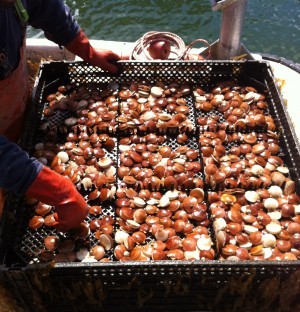 Sea scallop aquaculture in Maine is promising, but critical test marketing is hampered by low inventory, and the question of profitability can only be answered through actual delivery into the marketplace. This project will 1) Enable pilot-scale growers to increase their inventory, 2) facilitate test-marketing and communications with buyers and chefs, 3) collect information about price, volume, seasonal demand, and product form(s), 4) collect environmental data to optimize farm siting and husbandry and 5) track shell shape, and meat/roe/viscera weights, to build predictive capacity in production.
Sea scallop aquaculture in Maine is promising, but critical test marketing is hampered by low inventory, and the question of profitability can only be answered through actual delivery into the marketplace. This project will 1) Enable pilot-scale growers to increase their inventory, 2) facilitate test-marketing and communications with buyers and chefs, 3) collect information about price, volume, seasonal demand, and product form(s), 4) collect environmental data to optimize farm siting and husbandry and 5) track shell shape, and meat/roe/viscera weights, to build predictive capacity in production.
This project will work in collaboration with five existing Maine scallop farms to increase sales and profitability. Other farms are ‘waiting in the wings’ to see what transpires in the marketplace, including commercial fishermen who are considering aquaculture. A positive market outlook, combined with the supportive regulatory environment and existing knowledge, would improve diversity in Maine’s shellfish aquaculture industry, and the jobs it supports.
Development of a cultivation program for a morphologically distinct strain of the sugar kelp, Saccarina latissima forma angustissima from southern Maine
PI Charles Yarish, University of Connecticut
Funded amount: $25,000 Matching funds: $33,021
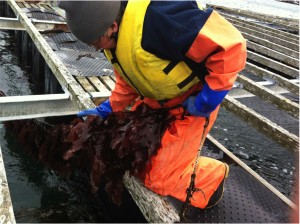 The overarching objective of this project is to find innovative and environmentally sustainable cultivation technology for the production of a unique phenotype of a relatively unknown kelp in southern Maine. The three components to the proposed research are to 1) determine the kelps’ optimum cultivation characteristics (light and temperature) in our seedstock nursery so that we can optimize the growth of the early developmental stages; 2) collaborate with Maine seaweed aquaculture farmers to cultivate this unusual kelp; and 3) to use DNA-fingerprinting to identify if the morphologically distinctive kelp is a different species from the common sugar kelp, Saccharina latissima, or a unique ecotype. This project will enhance the opportunities for a new cash crop of kelp for the Gulf of Maine farmers for culinary and other applications. It is anticipated that application of this novel variety of sugar kelp will bring new jobs for coastal Maine.
The overarching objective of this project is to find innovative and environmentally sustainable cultivation technology for the production of a unique phenotype of a relatively unknown kelp in southern Maine. The three components to the proposed research are to 1) determine the kelps’ optimum cultivation characteristics (light and temperature) in our seedstock nursery so that we can optimize the growth of the early developmental stages; 2) collaborate with Maine seaweed aquaculture farmers to cultivate this unusual kelp; and 3) to use DNA-fingerprinting to identify if the morphologically distinctive kelp is a different species from the common sugar kelp, Saccharina latissima, or a unique ecotype. This project will enhance the opportunities for a new cash crop of kelp for the Gulf of Maine farmers for culinary and other applications. It is anticipated that application of this novel variety of sugar kelp will bring new jobs for coastal Maine.
Mussel growout gear innovation
PI Peter Stocks, Trundy Point, LLC
Funded amount: $7,500 Matching funds: $8,120
 Maine’s mussel aquaculture industry has not nearly reached its potential due primarily to production based barriers. Existing mussel farm technology is expensive and ineffective at reducing the primary and sometimes catastrophic risks such as duck predation and mussel “drop-off”. Rope grown mussels are often grown on rafts which allow growers to deploy perimeter nets to protect mussels from sea duck predation. The nets are only partially effective and expensive to use. They also rub on grow-out ropes causing mussel drop-off. Presently there is no effective way to combat mussels “dropping-off” their ropes due to nets, high growth densities, increasingly warm waters and storms.
Maine’s mussel aquaculture industry has not nearly reached its potential due primarily to production based barriers. Existing mussel farm technology is expensive and ineffective at reducing the primary and sometimes catastrophic risks such as duck predation and mussel “drop-off”. Rope grown mussels are often grown on rafts which allow growers to deploy perimeter nets to protect mussels from sea duck predation. The nets are only partially effective and expensive to use. They also rub on grow-out ropes causing mussel drop-off. Presently there is no effective way to combat mussels “dropping-off” their ropes due to nets, high growth densities, increasingly warm waters and storms.
This project is testing an innovative mussel grow-out gear to eliminate duck predation, “drop-off” and the use of predator nets. It is expected that this novel method will reduce operating and capital costs, thereby increasing profitability for existing Maine farms and thereby attract investment to expand our industry.
ShellGIS – Modeling & mapping shellfish growth for improved site selection
Co-PI’s Carter Newell, Anthony Hawkins, Kevin Morris, John Richardson and Chris Davis
MAIC funding received by the Northeastern Regional Aquaculture Center
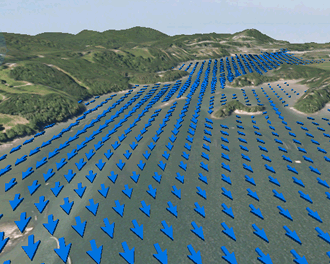 Practical models are required to help manage aquaculture production, including the effects of aquaculture on wider ecosystem services. To help address these and other shortcomings, ShellGIS has been developed as a custom application of STEMgis, a geographic information system (GIS) that handles additional dimensions of time and depth, within which we have embedded state-of-the-art models that account for interactive effects of culture type (i.e. suspended or bottom), shellfish density and hydrodynamics, as mediated through consequences for food supply, seawater temperature, salinity, seawater oxygen saturation and any aerial exposure. Developed over a four year period with support from the USDA-NIFA Northeastern Regional Aquaculture Center, efforts to date have focused on modeling shellfish growth around commercial oyster farms in the Damariscotta River estuary. The ShellGIS researchers hope to extend this modeling capability to other growing areas in Maine and beyond. More information on ShellGIS can be found by clicking here.
Practical models are required to help manage aquaculture production, including the effects of aquaculture on wider ecosystem services. To help address these and other shortcomings, ShellGIS has been developed as a custom application of STEMgis, a geographic information system (GIS) that handles additional dimensions of time and depth, within which we have embedded state-of-the-art models that account for interactive effects of culture type (i.e. suspended or bottom), shellfish density and hydrodynamics, as mediated through consequences for food supply, seawater temperature, salinity, seawater oxygen saturation and any aerial exposure. Developed over a four year period with support from the USDA-NIFA Northeastern Regional Aquaculture Center, efforts to date have focused on modeling shellfish growth around commercial oyster farms in the Damariscotta River estuary. The ShellGIS researchers hope to extend this modeling capability to other growing areas in Maine and beyond. More information on ShellGIS can be found by clicking here.
Development of a Coastal Observing Buoy
Co-PI’s Robert Prescott, Chris Davis and Carter Newell
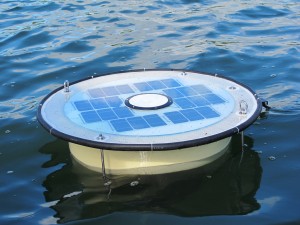 MAIC and Prescott Engineering are developing a low-cost environmental monitoring buoy for inshore applications. A variety of sensors will be available including temperature, conductivity (salinity), chlorophyll, turbidity and PAR (Photosynthetically Active Radiation). One application of the buoy will allow sea farmers to identify optimal growing site in conjunction with the ShellGIS platform by collecting both shellfish growth data and corresponding environmental parameters (growth drivers). Thus. a basket beneath the buoy can contain shellfish (oysters, mussels) in order to monitor growth rates while the buoy collects the environmental data. Telemetry of data will be by Wi-Fi or though a cellular modem.
MAIC and Prescott Engineering are developing a low-cost environmental monitoring buoy for inshore applications. A variety of sensors will be available including temperature, conductivity (salinity), chlorophyll, turbidity and PAR (Photosynthetically Active Radiation). One application of the buoy will allow sea farmers to identify optimal growing site in conjunction with the ShellGIS platform by collecting both shellfish growth data and corresponding environmental parameters (growth drivers). Thus. a basket beneath the buoy can contain shellfish (oysters, mussels) in order to monitor growth rates while the buoy collects the environmental data. Telemetry of data will be by Wi-Fi or though a cellular modem.
